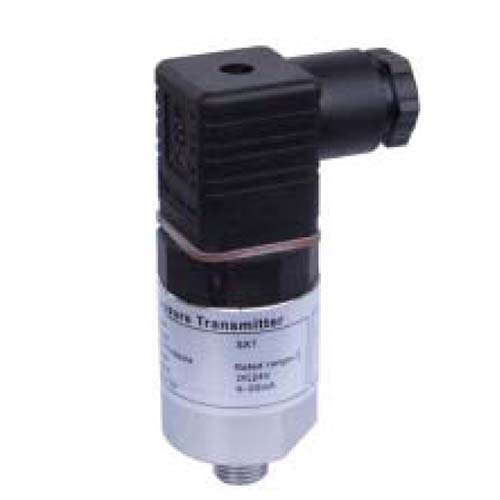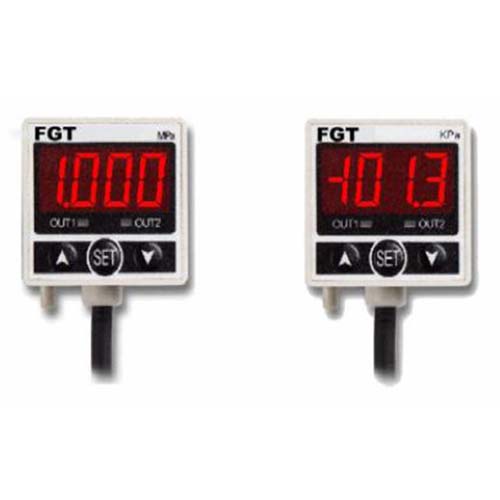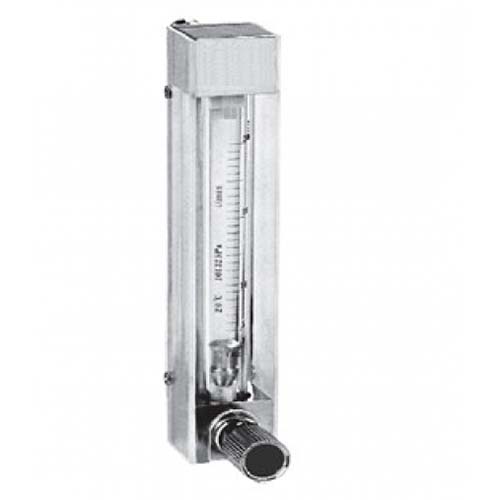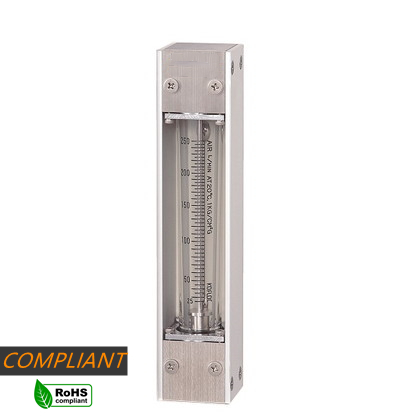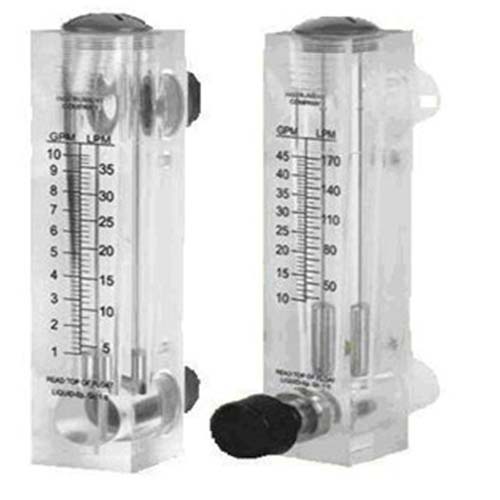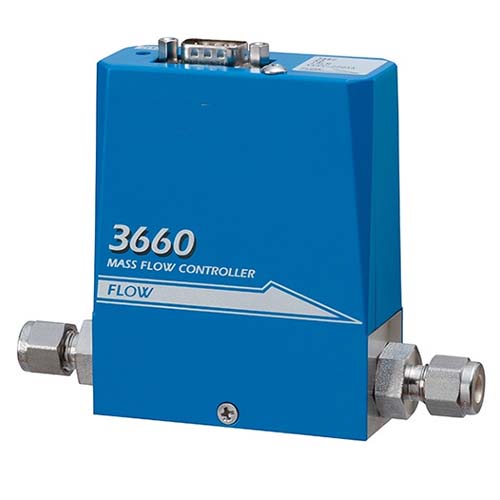FGT think your best choice in the future
System Integration Designers in FGT
SXT 類型:壓力傳送器
- SUS316本隔膜式可用在氣體和液體
- 輸出:4〜20mA或1〜5Vdc(精度0.25%)
- 2線(4〜20mA)或3線(1〜5VDC)
- 壓力t傳送器
- SUS316本隔膜式可用在氣體和液體
- 輸出:4〜20mA或1〜5Vdc(精度0.25%)
- 2線(4〜20mA)或3線(1〜5VDC)
- 壓力t傳送器
壓力傳送器[編輯]
壓力傳送器是用於測量液體與氣體的壓強的傳送器。與其他傳感器類似,壓力傳送器工作時將壓力轉換為電信號輸出。
壓力傳送器在很多監測與控制應用中得到大量的使用。除了直接的壓力測量,壓力傳送器同時也可用於間接測量其他量,如液體/氣體的流量,速度,水面高度或者海拔高度。
壓力傳送器在使用的技術,設計,性能表現,工作適應條件與價格上有很大的差異。初略估計,全世界有60種以上技術的壓力傳感器和至少300家企業生產壓力傳送器。
同時,也有一類的壓力傳送器設計用於動態測量高速變化的壓強。示例的應用有引擎氣缸的燃燒壓力或者渦輪發動機中氣體的壓強監測。這樣的傳送器一般以壓電材料製造,例如石英。
一些壓力傳送器,例如應用於交通執行照相機中的,則以二進位方式運行,也就是,當壓力達到某數值,則傳送器控制接通或斷開電路,這類型的壓力傳送器也被稱作壓力開關。
壓強測量類型[編輯]
壓力傳送器可以通過它們所能測量的壓強範圍,工作溫度以及壓強類型而進行分類;其中最重要的是壓強類型。若依壓強類型分類的方式中,壓力傳感器可以分為以下五類:
- 絕對壓力傳送器:
- 錶壓力傳送器(gauge pressure sensor):
- 這種壓力傳送器可以量測某一特定的位置下,相對大氣壓的壓強,胎壓計就是一個例子,當胎壓計顯示讀數為0PSI,表示輪胎內部的壓力等於大氣壓力,為14.7PSI。
- 真空壓力傳送器:
- 這種壓力傳送器用來量測小於一大氣壓的壓強,工業界有些真空壓力傳感器的讀值是相對於一大氣壓(讀值為負值),而有些是以其絕對壓力為準。
- 壓差計:
- 此儀器用來量測二個壓強之間的壓強差,例如量測濾油器兩端的壓力差,壓差計也用來量測流量或量測壓力容器內的液面高度。
- 密封壓力傳送器:
- 此儀器和錶壓力傳感器類似,不過此儀器會經過特別的校正,其量測的壓強是相對海平面的壓強。
供電要求[編輯]
恆流源和恆壓源都是通常壓力傳送器採用的兩種激勵。兩種激勵方法是有區別的,其作用不同。恆流源激勵有利於熱靈敏度漂移的補償作用。因為橋臂電阻器的溫度係數為正,而靈敏度溫度係數為負。恆流激勵時的輸出信號電壓的溫度係數是兩者的代數和。而恆壓激勵不能直接提供靈敏度溫度補償效果。但用恆壓源激勵時可在橋外串接熱敏電阻或二極體以補償熱靈敏度漂移。用橫流激勵時,這種靈敏度補償方法便不起作用。可見,恆壓源和恆流源激勵互相之間不能隨意互換。
另外,又可将压力传感器的激励电源分为正比激励和固定激励。前者是将压力雌 深[暈 暈超恩 蛇窟ㄟㄑㄟ传感器电桥直接接到电源上,当电源改变时,压力传感器的灵敏度和零点都随之发生变化。后者内部有一个参考电压,压力传感器电桥由参考电压供电激励。参考电压是恒定的,与电源无关。只要电源电压在一指定电压范围内变化,参考电压不变。因而传感器的输出不变,不受电源电压的影响。
壓強偵測技術[編輯]
| 此章節需要擴充。 (2010年7月26日) |
應用[編輯]
壓力傳送器有以下的應用:
- 壓強測量
- 海拔感知
- 流量測量
- 水平面/深度 測量
- 泄漏探測
應用領域
Pressure sensors: 3 industrial applications enabling the smart factory
Real-time sensor data is enabling factories to better understand their own processes and keep them running. And putting that data into the IIoT also helps optimise how raw materials are ordered, handled and consumed. Knowing what to reorder and when can keep continuous processes at high capacity.
Smart manufacturing is changing the way we make, package and distribute just about everything, but Industry 4.0 is revolutionising the way our factories operate. While the Industrial IoT is dependent on connectivity, fundamentally it’s harnessing raw data and turning that into operational intelligence, which means sensors are key to the entire process. While there are many types of sensor at play here, the pressure sensor is probably the most diverse and widely deployed type of sensor in the IIoT.
1. Monitoring process flows
Differential pressure sensors are used extensively in process flows where a fluid needs to pass through some form of barrier, such as a filter. Under normal conditions the pressure difference between the upstream (often called the line or influent pressure) and the downstream (effluent) pressure should be nil or minimal. As the filter becomes blocked with contaminants, the downstream pressure will decrease, which causes the difference measured to increase.
The sensor’s output can be calibrated to show the maximum permissible pressure difference at full scale. For example, a 4-20mA output could be calibrated to show 20mA when the pressure difference reaches the maximum permissible, but read 4mA when the pressure difference is nil.
2. Measuring safe levels in liquid tanks
Submersible pressure sensors that are certified for use in intrinsically safe areas can be used to measure liquid pressures of up to 30 PSI with either a voltage or current (4-20mA) output. Positioning a submersible pressure sensor at the bottom of a tank would provide an accurate reading of the contents of the tank, thereby alerting workers or the process control system when the level in the tank falls below an allowable lower limit.
The pressure at the bottom of a tank – normally called the hydrostatic or head pressure – is measured in units of distance (feet, inches, meters) of water columns. For example, 27.670 inches of water column (WC) is around the same as 1 PSI at 100°F.
The pressure measured is only dependent on the height of the tank (as opposed to its shape) or the volume of the liquid. For this reason it is important that the sensor is placed at the bottom of the tank (instead of half way down).
Process controllers can calculate the level of liquid in a tank by measuring the hydrostatic pressure, which is more accurately measured when the density of the liquid is also known.
3.Managing control loops
As well as being used to monitor processes, pressure sensors are often instrumental in the control loop. This is particularly relevant in the use of hydraulics, where pressurised fluids are used to apply effort in presses or lifts for example.
The sensors are often small, particularly those based on MEMS technology. They can measure less than 2mm on each side yet be capable of measuring absolute pressures in the region of 20 Bar or more. This makes them suitable in a range of applications, including medical and automotive.
Even smarter sensors
Smart factories are now employing smarter sensors, such as pressure sensors with built-in Bluetooth connectivity, allowing them to be monitored wirelessly. These sub-systems feature a gauge pressure sensor, Analog to Digital Converter and Bluetooth radio in a single sealed unit that can be mounted in places where adding wires may be difficult. As they are battery-powered they can operate autonomously for as much as two years without any maintenance, providing accurate pressure sensor readings for gases, liquids and even mildly corrosive fluids.
Pressure sensors are fundamental in the smart factory and in enabling Industry 4.0.

